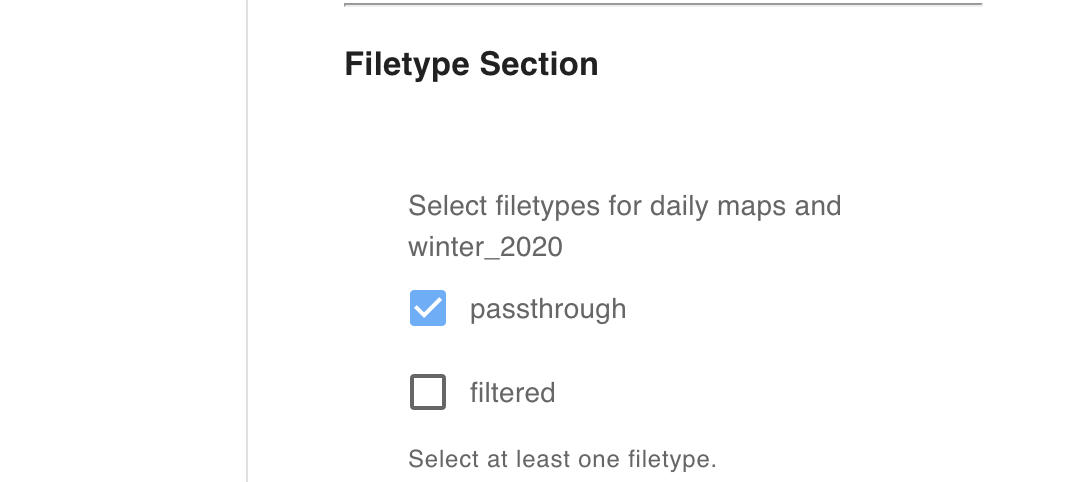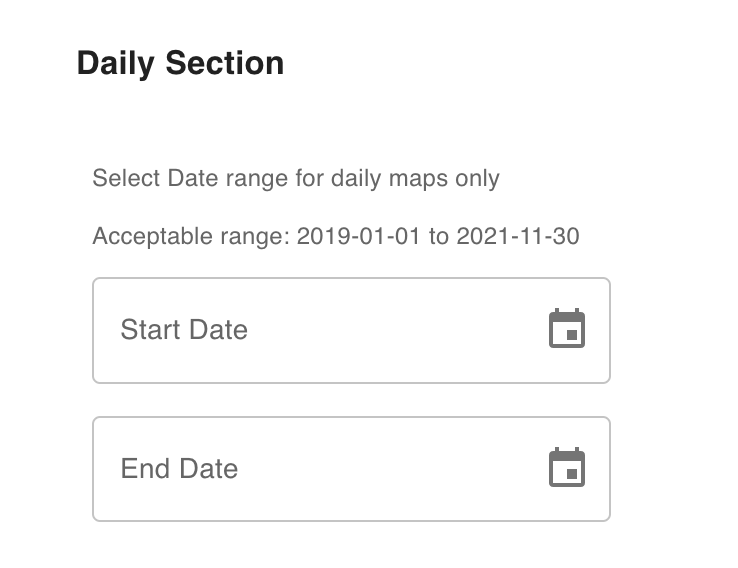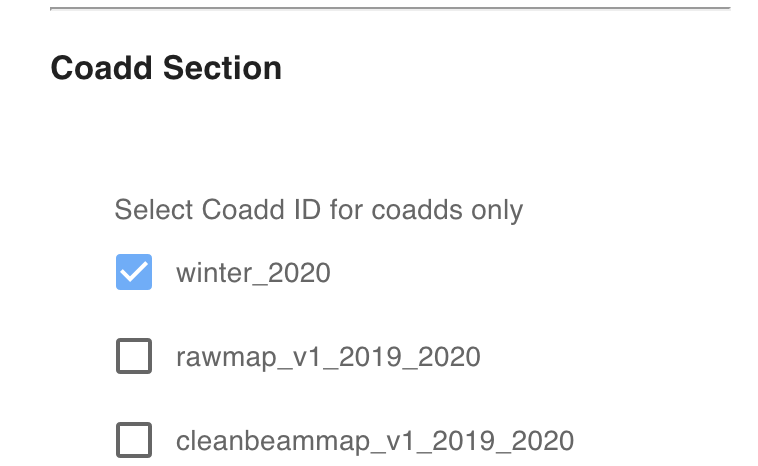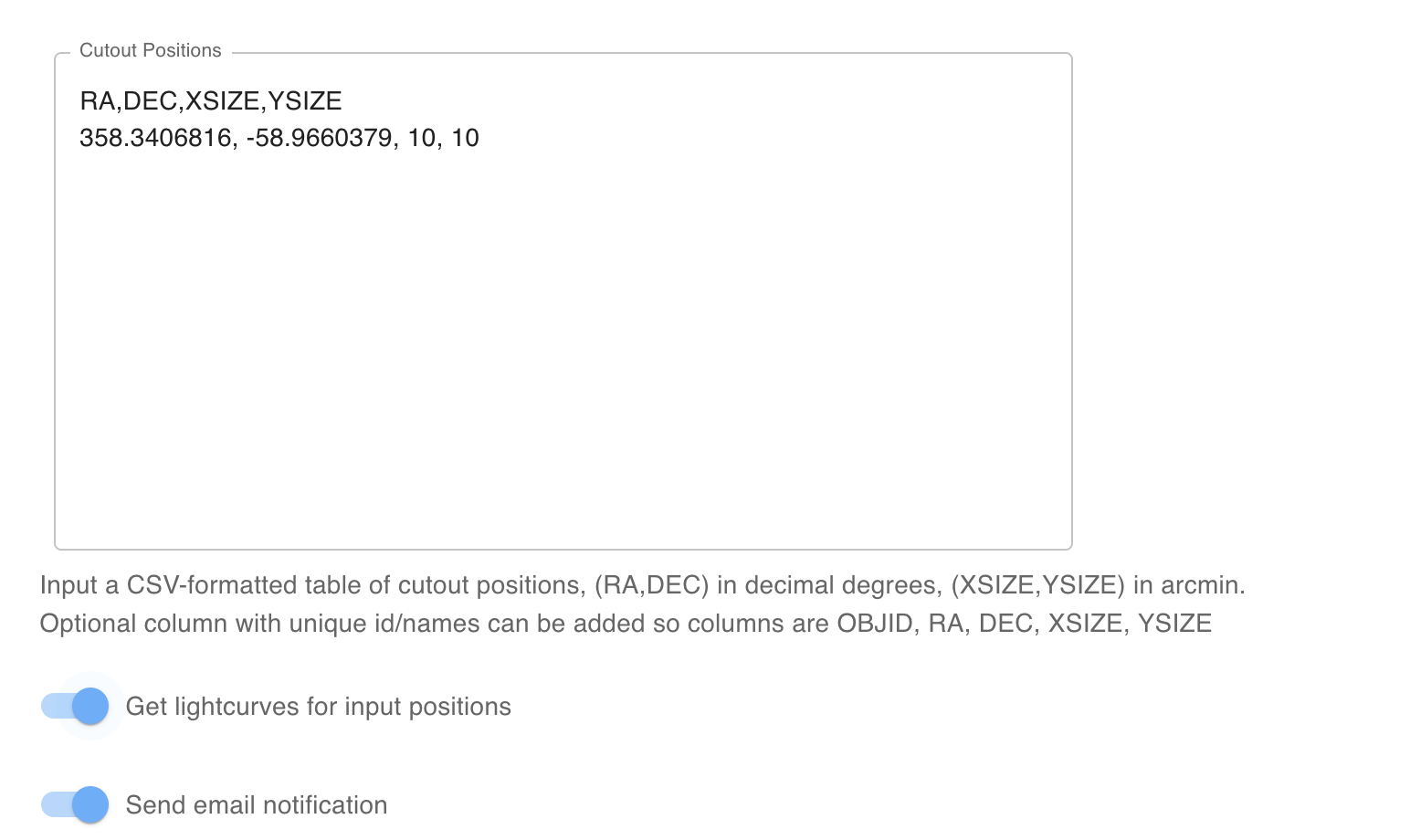User Manual
Cutout Service
Introduction
The cutout service allows users to launch asynchronous jobs to generate thumbnails from SPT-3G maps centered on user-supplied RA/DEC coordinates and side dimensions.
Cutter Web App
Before proceeding make sure you have registered as a user of the service. Please follow these instructions
The SPT-3G cutout server is located at: https://spt3g.ncsa.illinois.edu/app/cutout

File Types for cutouts
The cutout server has the ability to generate cutouts from SPT3G maps of two different flavors:
Passthrough (extension
psth), cuts from the passthrough fits maps (i.e. originalg3files were not touched, just dumped as fits)Filtered (extension
fltd), cuts from the filtered fits files. Here filtering means the SPT3G transient filtering, but without the subtraction of the coadds.
Map Types for cutouts
The cutout server also has the ability to cut from two types of SPT3G maps:
Single Observation Maps, these are the maps from individual observation scans from 3G. We try to stay up-to-date with 3G files at NCSA. At the moment the server can generate cutouts for Single Observations maps with the date range 2019-01-01 to 2021-11-30. The server has the ability to make cutouts from Single Observation maps that can be both
passthroughandfiltered. You can make this selection in the “Single Observation Section” of the web interphase.
Yearly Coadds, these are the yearly coadd maps. These are curated maps and at the moment we have 3 versions to choose from:
winter 2020, these are the canonical yearly coadds from the spt3g pipeline.
rawmap_v1_2019_2020, custom rawmap coadds from Melanie Archipley.
cleanbeammap_v1_2019_2020, custom filtered coadds from Melanie Archipley.
Note: Only for the winter2020 both
passthroughandfilteredfiletypes are available. For other coadds onlypassthrough.
List of objects and Coordinates
The server accepts a comma-separated values (csv) list with columns of two types, with or without an identifier column (OBJID) for the coordinates. The RA,DEC coordinates need to be in sexagesimal degrees and XSIZE, YSIZE need to be in arcminutes. Note that XSIZE, YSIZE can be different (or the same) for each coordinate pair. The optional OBJID needs to have different entries for each row.
Without
OBJID, columns are:RA,DEC,XSIZE,YSIZEAn example list:
RA,DEC,XSIZE,YSIZE 358.3406816, -58.9660379, 10, 10 355.8253677, -57.1623017, 10, 10 332.6717176, -50.4503607, 10, 10 339.6060170, -51.2397203, 10, 10 334.9264663, -52.9082500, 10, 10
With
OBJID, columns are:OBJID,RA,DEC,XSIZE,YSIZEAn example list with
OBJID:OBJID,RA,DEC,XSIZE,YSIZE OBJ_01, 358.3406816, -58.9660379, 10, 10 OBJ_02, 355.8253677, -57.1623017, 10, 10 OBJ_03, 332.6717176, -50.4503607, 10, 10 OBJ_04, 339.6060170, -51.2397203, 10, 10 OBJ_05, 334.9264663, -52.9082500, 10, 10 OBJ_06, 20.9509332, -46.3929102, 10, 10

Lightcurves
The server provides the option to retrieve lightcurves for each pair of coordinates (i.e. object) supplied. The data points for each lightcurve represent the pixel values at the requested coordinate of each object for which a cutout was generated. The “flux” comes from the first HDU of the fits file, and the associated uncertainty from the second HDU. The lightcurves are written as Python dictionaries in yaml format and contained in the file lightcurve.yaml.
Generate cutouts
Press, only once the GENERATE CUTOUTS button to submit your job.
Job Status
The status of all the jobs submitted by the users is available on the STATUS page.

Email notification and Retrieving Files

If you selected Send email notification (recommened), after your job has been completed you will receive an email notification, with instructions on how to retrieve your files. For small jobs, you can download/inspect indivual files using a web browser. For larger jobs we recommend bulk downloads using wget.
Back-end Code
The back-end code for the web app is the open source and python-based package spt3g_cutter.
SPT-3G Cutter API
For users who do not want to use the web app, we recommend the SPT-3G API.
API Tutorial
Disclaimer: This example script may not be maintained diligently, although the basics should be stable. Check the docs for the latest version of the API example script.
📄 Copy this entire folder to your home folder.
Generate an API token by visiting your SPT-3G account page. You can also find an API token displayed on the Home page of the Cutout web app.
export SPT_API_TOKEN="PASTE_TOKEN_HERE"
Update the file job_config.yaml as needed and run.
cd ~/API_tutorial
./API_example.py
Need Help
Feel free to send comments or suggestions for upgrades and improvements to Felipe Menanteau and/or Andrew Manning